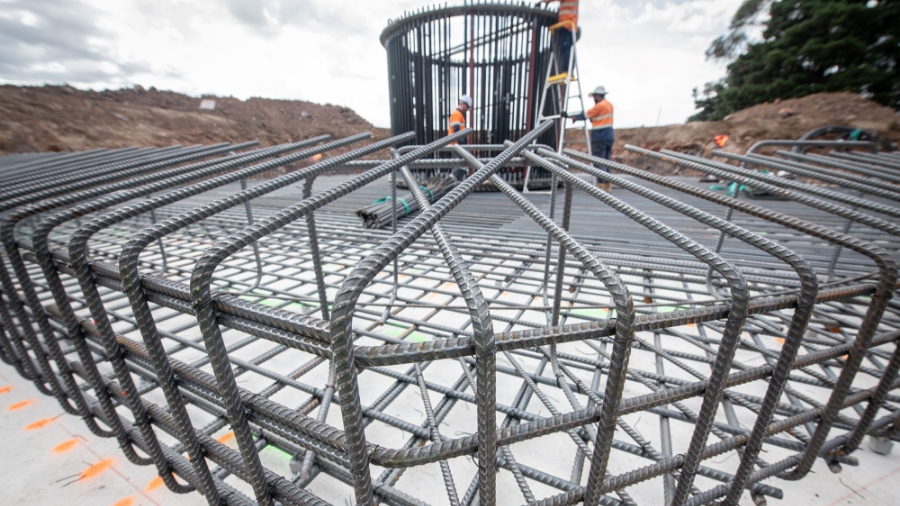
WE ARE HERE TO HELP YOU BUILD USING REINFORCED CONCRETE
Our mission is to support reinforcing steel quality and capability in Australia’s building and construction industry. As a not-for-profit Institute, we provide the building industry with technical support and information relating to the use of rebar and mesh in concrete construction.
Founded in 1988, we are funded primarily by our Processor Members who supply most of Australia’s steel reinforcement requirements. The Institute is also supported by our local Steel Mill member, InfraBuild, and Associate members.
OUR OBJECTIVES

MEMBER SERVICES
Develop excellence in the manufacture and supply of steel reinforcement by establishing QUALITY AND SAFETY BENCHMARKS for membership.
TECHNICAL LEADERSHIP
Inform the building industry about steel reinforcement advancements through SEMINARS, RESEARCH PROGRAMS, SITE TOURS and FREE TECHNICAL SUPPORT.

AWARDS
- 2022 Colin Crisp Award – Engineering Conservation Project Winner for Guide to Historical Steel Reinforcement in Australia by Engineers Australia.
- 2020 Australian Engineering Excellence Awards Finalist – Guide to Historical Steel Reinforcment in Australia by Engineers Australia.
- 2019 NSW Award for Excellence – Guide to Historical Steel Reinforcement in Australia by Concrete Institute of Australia.
RECENT SEMINARS & LECTURES
- Earthquakes and AS 3600 – Association of Consulting Structural Engineers of Victoria (ACSEV)
- Residential Slabs and Footings Construction Requirements – Engineers Australia, SA Footings Group
- Design and Detailing for Resilience and Sustainability of Concrete Structures – Concrete 2023
RESEARCH
- Class L Mesh Slabs – Curtin University
- Seismic performance of precast concrete structures – University of Melbourne
- Performance of reinforced concrete frames with masonry infill panels – University of Adelaide
POPULAR PUBLICATIONS
TECHNICAL LIBRARY
- Extensive in-house library of books about the design and use of steel reinforcement in Australia. A major contributor to the library is John Woodside OAM. Open to the public by appointment.

CODES, STANDARDS AND REGULATIONS
Support modern, easy-to-use steel reinforcement design Standards.
The SRIA strives to achieve quality and continuous improvement through its active involvement in the following Standards Australia Committees:
- BD-002 Concrete structures (AS 3600)
- WD-003 Welding of structures (AS 1554)
- BD-006 Structural design actions (AS 1170)
- BD-025 Residential slabs and footings (AS 2870)
- BD-066 Tilt-up concrete construction (AS 3850)
- BD-084 Steel reinforcing materials (AS/NZS 4671)
- BD-090 Bridge design (AS 5100) BD-098 Guide to residential pavements (AS 3727)
MARKET DEVELOPMENT
Promote the proven benefits of reinforced concrete to ensure it remains the material of choice for Australia’s built environment.
DURABLE
Durability is the #1 reason for why Australians choose reinforced concrete. Australia’s first reinforced concrete structure, Johnston’s Creek Sewer Aqueduct in Annandale (Sydney), was completed in 1896 to carry sewerage from the densely populated inner west suburbs of Balmain, Annandale and Glebe. The 127-year-old aqueduct continues to serve the local community today.
VERSATILE
No other building material provides the design freedom like reinforced concrete. Large open spaces are created through expansive column spacing with reinforced concrete. Monolithic structures and innovative shapes can be achieved with reinforced concrete because it can be moulded and formed in-situ and designed with no transport limitations.
ECONOMICAL
Reinforced Concrete offers greater ‘lifetime’ value than other building materials. Steel reinforcement and concrete are produced at scale in Australia and distributed by competitive supply chains with stringent quality standards. We have a highly skilled trade base for the design, production, transport, and construction of reinforced concrete structures. Hence, the speed of construction is unmatched by any other building material. Minimal maintenance is another key factor for why reinforced concrete is cost efficient.
SUSTAINABLE
Steel is a 100% recyclable material, with no loss in material strength or quality. Steel reinforcement is manufactured locally using recycled steel as a key part of our circular economy. This steel is produced in an electric arc furnace using electricity to melt the scrap metal. As our power supply transitions from fossil fuels to renewable sources, such as wind, solar, and hydrogen, steel will become increasingly more sustainable.
Another eco-friendly characteristic of reinforced concrete is its capacity to be adapted and repurposed, such as AMP’s Quay Quarter Tower in Sydney.
RESILIENT
In a country where almost 90% of the population live within 50km of the coast, Australian structures need to withstand highly exposed environments. Steel in concrete gives designers’ confidence that the structure will endure harsh weather conditions over the long term. The properties of reinforced concrete contribute to its resilience following natural disasters. Strength against cyclones and severe storms, impervious to water damage from floods, and resistance to hail, heatwaves, and fire (incombustible), makes reinforced concrete the safest method of construction.
MEET THE TEAM

SCOTT MUNTER
BE FIE AUST CPENG NPER (STRUCTURAL)
CEO / Executive Director

ERIC LUME
BE MIE AUST CPENG (RET)
National Engineer

BRIGITTE BROKENBROW
Administrative Assistant

JOHN McCARL
Marketing Consultant
AUSTRALIAN INDUSTRY PARTNERS
INTERNATIONAL INDUSTRY PARTNERS










